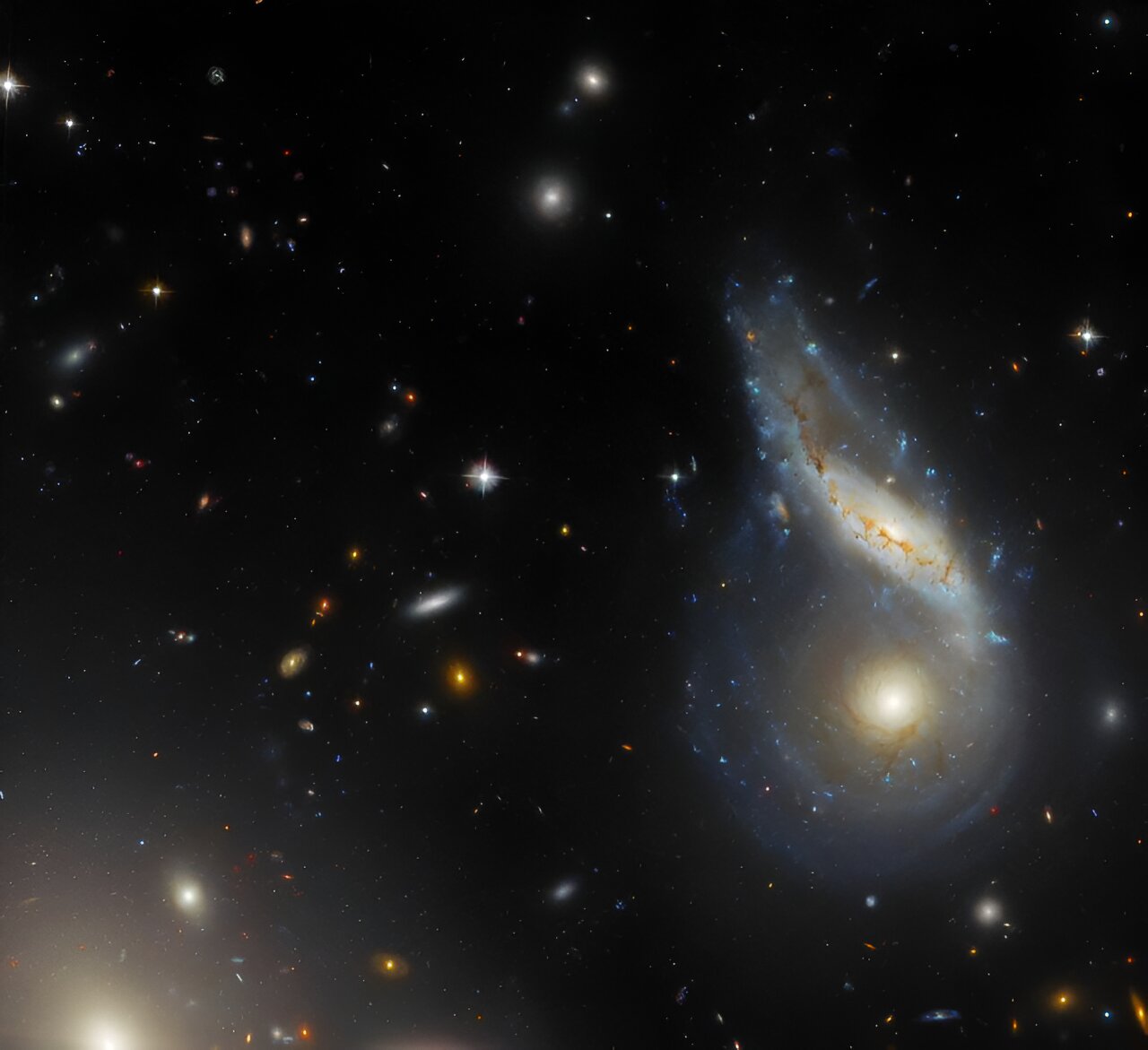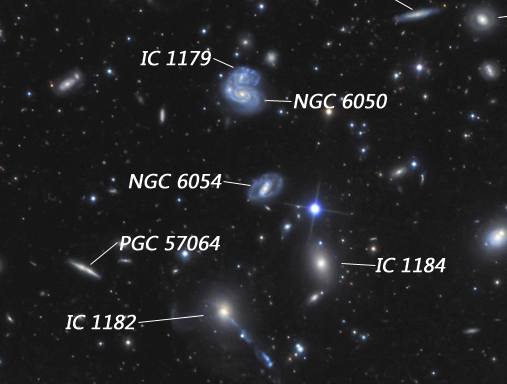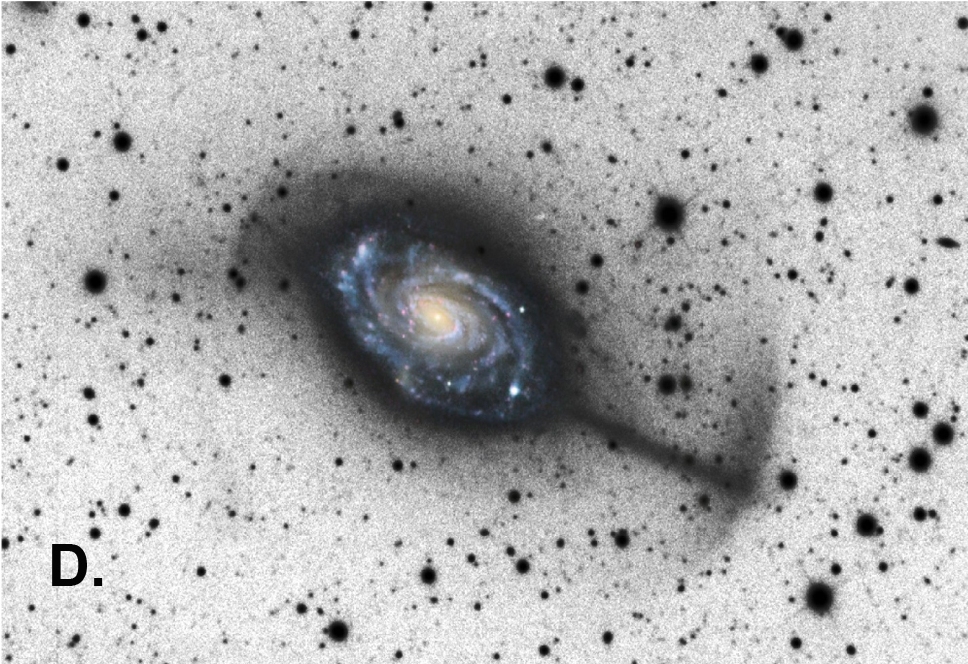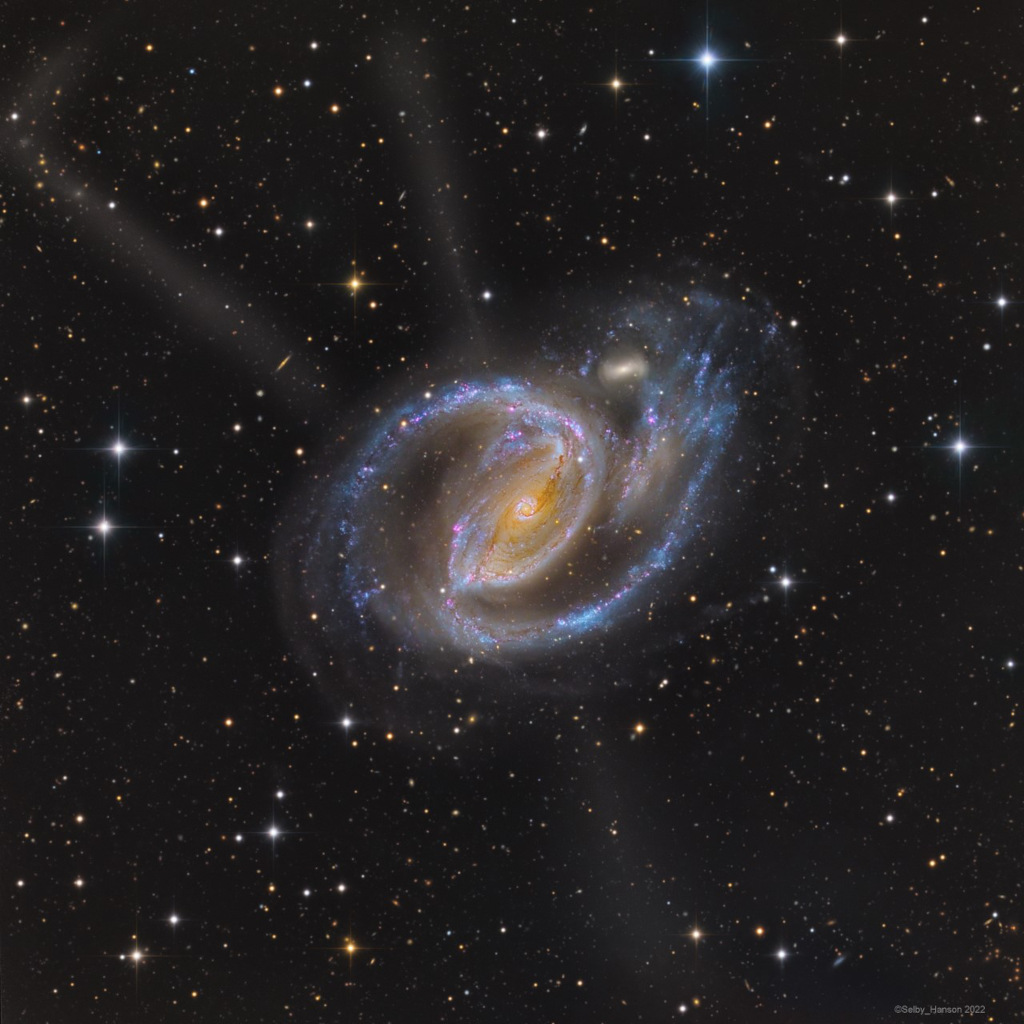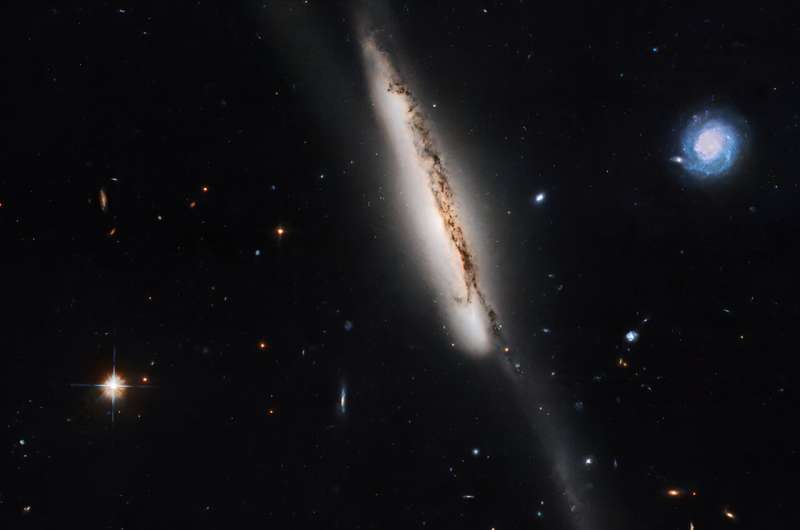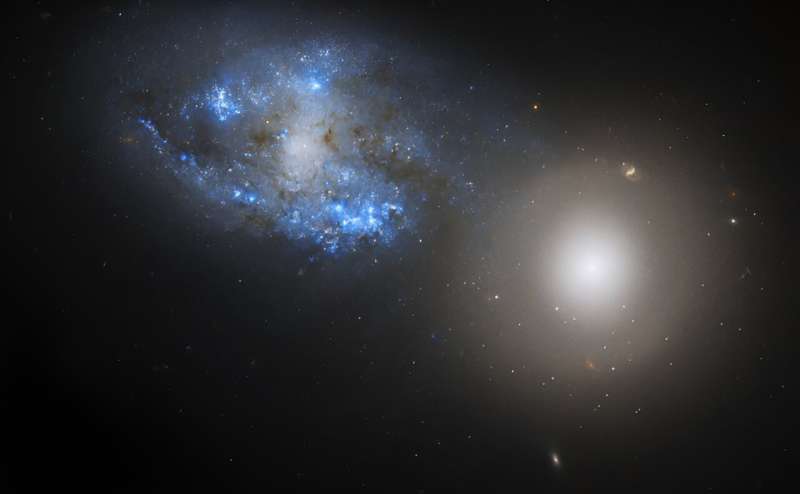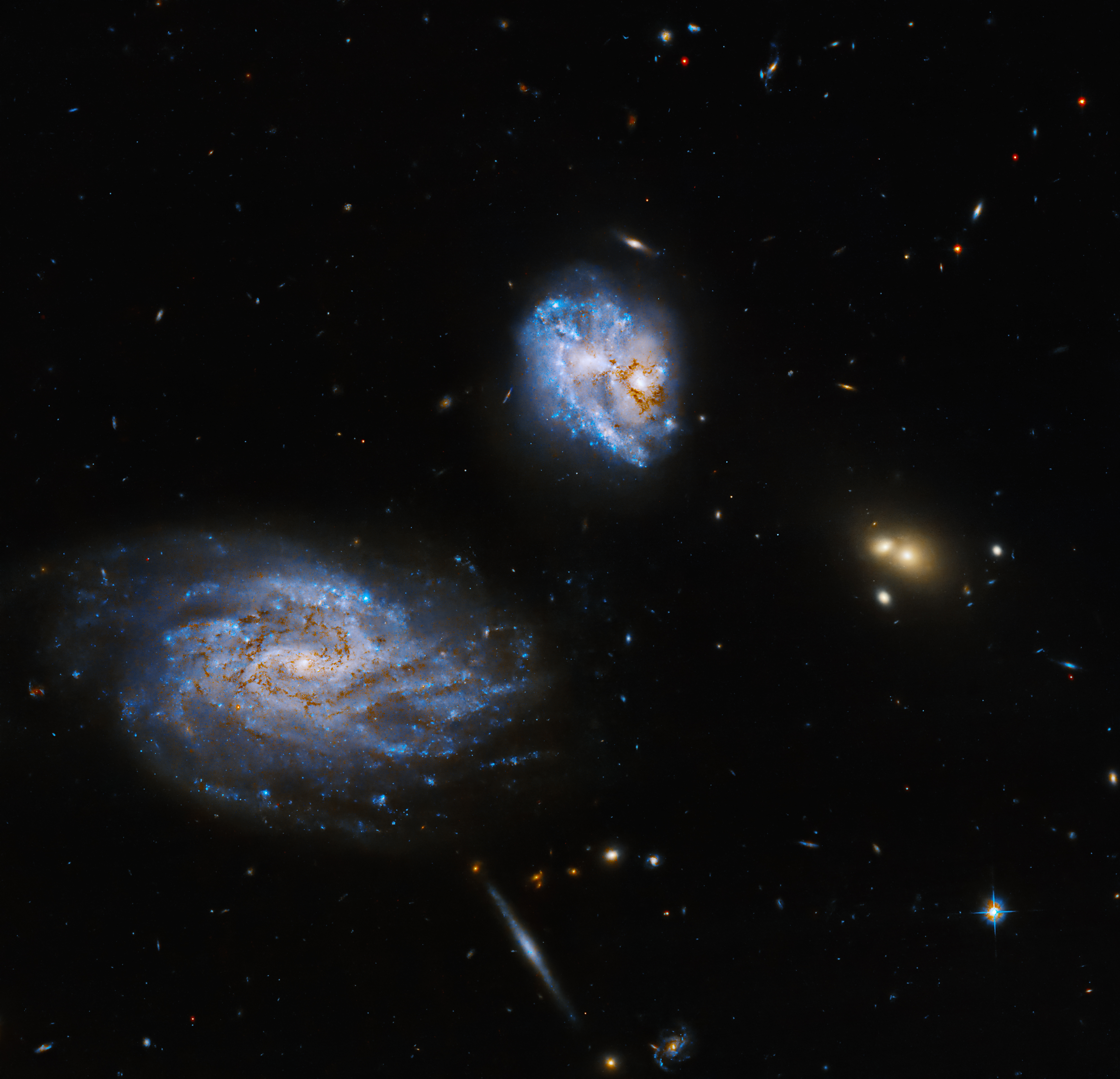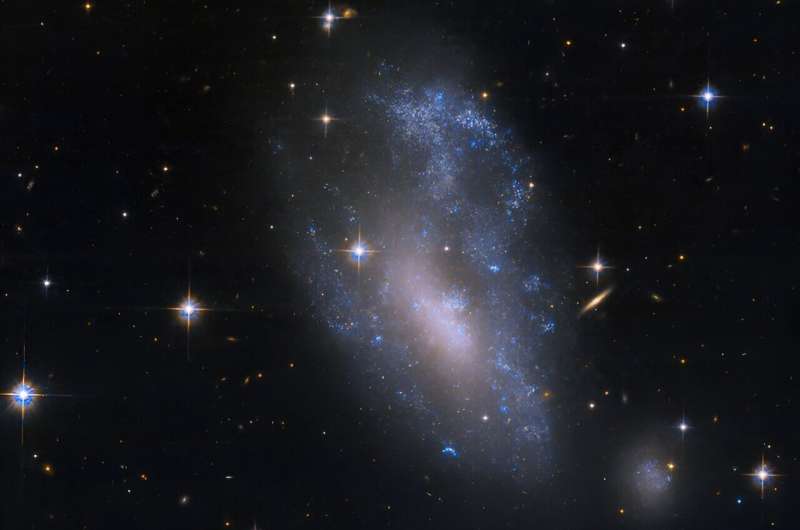AVAO wrote: ↑Fri Nov 17, 2023 4:38 pm This is a news channel for discussing new images of galaxies that have been recently released.
To see the latest posts in reverse order, press this link!
GOTD: Galaxy Of The Day
- AVAO
- Commander
- Posts: 526
- Joined: Tue May 28, 2019 12:24 pm
- AKA: multiwavelength traveller
- Location: Zurich, Switzerland
GOTD: Galaxy Of The Day
- AVAO
- Commander
- Posts: 526
- Joined: Tue May 28, 2019 12:24 pm
- AKA: multiwavelength traveller
- Location: Zurich, Switzerland
Re: GOTD: Galaxy Of The Day
Hubble glimpses bright galaxy group LEDA 60847
NASA/ESA | 2024 Jan 23
NASA/ESA | 2024 Jan 23
GOTD4Y JacLEDA 60847 is classified as an active galactic nuclei, or AGN. An AGN has a supermassive black hole in the galaxy's central region that is accreting material. The AGN emits radiation across the entire electromagnetic spectrum and shines extremely brightly. By studying powerful AGNs that are relatively nearby, astronomers can better understand how supermassive black holes grow and affect galaxies.
...
This image of LEDA 60847 combines ultraviolet, visible, and near-infrared data from Hubble. The ability to see across all those wavelengths is one of the things that makes Hubble unique.
... more
Re: GOTD: Galaxy Of The Day
Wow, Jac, that's amazing!!!AVAO wrote: ↑Thu Jan 25, 2024 5:49 am Hubble glimpses bright galaxy group LEDA 60847
NASA/ESA | 2024 Jan 23
GOTD4Y JacLEDA 60847 is classified as an active galactic nuclei, or AGN. An AGN has a supermassive black hole in the galaxy's central region that is accreting material. The AGN emits radiation across the entire electromagnetic spectrum and shines extremely brightly. By studying powerful AGNs that are relatively nearby, astronomers can better understand how supermassive black holes grow and affect galaxies.
...
This image of LEDA 60847 combines ultraviolet, visible, and near-infrared data from Hubble. The ability to see across all those wavelengths is one of the things that makes Hubble unique.
... more
Let me try to analyze a little of what I think I might see:
I can see some huge yellow shells surrounding the main elliptical galaxy. These shells are made up of old stars, and I have marked them in yellow. So, is there a reason why I left "gap" in the shell at center right? Not really, no.
The edge-on spiral galaxy seen in front of the large elliptical seems to blow a huge "bubble". There is some star formation in this bubbe, so I have marked it in blue. What could have blown such an enormous bubble? A supernova, or a series of supernovas? But supernova remnants are typically more tattered and broken, aren't they? And they have sharper edges, like the Veil Nebula, right? And it can't be the kind of major outburst that leaves two huge lobes of emission, like the gamma ray Fermi lobes or the hydrogen alpha outflows of M82. Could the bubble actually be a tidal feature?
At the opposite end of the disk of that spiral, there is a much smaller but still very obvious bluish-pinkish-purplish blob. I take this to be a sign of star formation - because surely it can't be a huge supernova remnant, can it?? - so I have marked it in blue.
The center of the spiral galaxy is brilliantly bright and pink. I have marked it with a pink question mark. I take the color to be caused by emission at various wavelengths, among them ultraviolet. What comes to mind is an actively accreting black hole with a brilliantly bright accretion disk. But is that really likely? Shouldn't we expect the large elliptical galaxy to host a more powerful black hole? Yet we see no diffraction spikes from the center of the elliptical galaxy. Is it possible that there is a huge burst of star formation at the center of the spiral galaxy? Normally though, we'd expect such a burst of star formation to be accompanied by massive dust production, and we see few signs of dust at the center of the spiral galaxy.
All right, yeah!! The bright pink "star" is an actively accreting black hole. I should have read the NASA caption:
So maybe the huge bubble and the big blob of the spiral galaxy have indeed been blown by the active black hole, then?NASA wrote:
LEDA 60847 is classified as an active galactic nuclei, or AGN. An AGN has a supermassive black hole in the galaxy's central region that is accreting material. The AGN emits radiation across the entire electromagnetic spectrum and shines extremely brightly.
I have placed question marks near three smaller galaxies in the lower third of the picture. What I'm asking is whether these galaxies are at the same distance as the two main galaxies, or if they are background or possibly even foreground objects. I think that the small lens-shaped galaxy just below the main spiral galaxy may be at the same distance as the two main galaxies, and it may be part of the action.
I'm going to guess that the galaxy at far right is either at the same distance as the two main galaxies, or else it might be a foreground galaxy. Its surface brightness is pretty low, which suggests to me that it is a low-mass dwarf galaxy, and its color is white, not yellow. Its white color suggests to me that it is a low-metallicity, reasonably "untouched" galaxy that has had little interaction with other galaxies, and whose stars are very old and made of quite pristine gas. Of course I could be wrong about that!
The small spiral galaxy at left looks like a background galaxy to me. It is a gas-rich galaxy, and if it was so close to two merging galaxies, I think its shape would be affected. Anyway, the appearance of this galaxy reminds me very much of the face-on spiral galaxy in Seyfert's Sextet, and that galaxy is a background object:
LEDA 60847 with possible spiral background galaxy at left.
Credit: NASA/ESA/A. Barth, M Koss, A Robinson, Gladys Cooper.
Credit: NASA/ESA/A. Barth, M Koss, A Robinson, Gladys Cooper.
Finally, in the LEDA 60847 image there is a small galaxy at far right that looks like a cometary galaxy to me, a galaxy whose disk is very bright at one end, like a comet coma!
And now I'm done! Phew! Thanks for finding this great galaxy image, Jac!
Ann
Color Commentator
- AVAO
- Commander
- Posts: 526
- Joined: Tue May 28, 2019 12:24 pm
- AKA: multiwavelength traveller
- Location: Zurich, Switzerland
Re: GOTD: Galaxy Of The Day
Ann wrote: ↑Thu Jan 25, 2024 7:24 amWow, Jac, that's amazing!!!AVAO wrote: ↑Thu Jan 25, 2024 5:49 am Hubble glimpses bright galaxy group LEDA 60847
NASA/ESA | 2024 Jan 23
GOTD4Y JacLEDA 60847 is classified as an active galactic nuclei, or AGN. An AGN has a supermassive black hole in the galaxy's central region that is accreting material. The AGN emits radiation across the entire electromagnetic spectrum and shines extremely brightly. By studying powerful AGNs that are relatively nearby, astronomers can better understand how supermassive black holes grow and affect galaxies.
...
This image of LEDA 60847 combines ultraviolet, visible, and near-infrared data from Hubble. The ability to see across all those wavelengths is one of the things that makes Hubble unique.
... more

Let me try to analyze a little of what I think I might see:
hubble-leda60847-3-flat-final[1].jpgLEDA 60847 galaxies NASA ESA A Barth M Koss.png
I can see some huge yellow shells surrounding the main elliptical galaxy. These shells are made up of old stars, and I have marked them in yellow. So, is there a reason why I left "gap" in the shell at center right? Not really, no.
The edge-on spiral galaxy seen in front of the large elliptical seems to blow a huge "bubble". There is some star formation in this bubbe, so I have marked it in blue. What could have blown such an enormous bubble? A supernova, or a series of supernovas? But supernova remnants are typically more tattered and broken, aren't they? And they have sharper edges, like the Veil Nebula, right? And it can't be the kind of major outburst that leaves two huge lobes of emission, like the gamma ray Fermi lobes or the hydrogen alpha outflows of M82. Could the bubble actually be a tidal feature?
At the opposite end of the disk of that spiral, there is a much smaller but still very obvious bluish-pinkish-purplish blob. I take this to be a sign of star formation - because surely it can't be a huge supernova remnant, can it?? - so I have marked it in blue.
The center of the spiral galaxy is brilliantly bright and pink. I have marked it with a pink question mark. I take the color to be caused by emission at various wavelengths, among them ultraviolet. What comes to mind is an actively accreting black hole with a brilliantly bright accretion disk. But is that really likely? Shouldn't we expect the large elliptical galaxy to host a more powerful black hole? Yet we see no diffraction spikes from the center of the elliptical galaxy. Is it possible that there is a huge burst of star formation at the center of the spiral galaxy? Normally though, we'd expect such a burst of star formation to be accompanied by massive dust production, and we see few signs of dust at the center of the spiral galaxy.
All right, yeah!! The bright pink "star" is an actively accreting black hole. I should have read the NASA caption:
So maybe the huge bubble and the big blob of the spiral galaxy have indeed been blown by the active black hole, then?NASA wrote:
LEDA 60847 is classified as an active galactic nuclei, or AGN. An AGN has a supermassive black hole in the galaxy's central region that is accreting material. The AGN emits radiation across the entire electromagnetic spectrum and shines extremely brightly.
I have placed question marks near three smaller galaxies in the lower third of the picture. What I'm asking is whether these galaxies are at the same distance as the two main galaxies, or if they are background or possibly even foreground objects. I think that the small lens-shaped galaxy just below the main spiral galaxy may be at the same distance as the two main galaxies, and it may be part of the action.
I'm going to guess that the galaxy at far right is either at the same distance as the two main galaxies, or else it might be a foreground galaxy. Its surface brightness is pretty low, which suggests to me that it is a low-mass dwarf galaxy, and its color is white, not yellow. Its white color suggests to me that it is a low-metallicity, reasonably "untouched" galaxy that has had little interaction with other galaxies, and whose stars are very old and made of quite pristine gas. Of course I could be wrong about that!
The small spiral galaxy at left looks like a background galaxy to me. It is a gas-rich galaxy, and if it was so close to two merging galaxies, I think its shape would be affected. Anyway, the appearance of this galaxy reminds me very much of the face-on spiral galaxy in Seyfert's Sextet, and that galaxy is a background object:
hubble-leda60847-3-flat-final[1].jpgLEDA 60847 with possible spiral background galaxy at left.
Credit: NASA/ESA/A. Barth, M Koss, A Robinson, Gladys Cooper.
Finally, in the LEDA 60847 image there is a small galaxy at far right that looks like a cometary galaxy to me, a galaxy whose disk is very bright at one end, like a comet coma!
And now I'm done! Phew! Thanks for finding this great galaxy image, Jac!
Ann
Wow. ThanX Ann 4 your very interesting explanations!
jac berne (flickr) HST WFC3 uvis
- AVAO
- Commander
- Posts: 526
- Joined: Tue May 28, 2019 12:24 pm
- AKA: multiwavelength traveller
- Location: Zurich, Switzerland
Re: GOTD: Galaxy Of The Day
Hubble captures a monster merger
PHYS.ORG | 2024 Jan 15
PHYS.ORG | 2024 Jan 15
GOTD4Y JacThis NASA/ESA Hubble Space Telescope image features Arp 122, a peculiar galaxy that in fact comprises two galaxies—NGC 6040, the tilted, warped spiral galaxy and LEDA 59642, the round, face-on spiral—that are in the midst of a collision. This dramatic cosmic encounter is located at the very safe distance of roughly 570 million light-years from Earth. Peeking in at the lower-left corner is the elliptical galaxy NGC 6041, a central member of the galaxy cluster that Arp 122 resides in, but otherwise not participating in this monster merger.
...
... more
- AVAO
- Commander
- Posts: 526
- Joined: Tue May 28, 2019 12:24 pm
- AKA: multiwavelength traveller
- Location: Zurich, Switzerland
Re: GOTD: Galaxy Of The Day
AVAO wrote: ↑Fri Jan 26, 2024 9:43 pm Hubble captures a monster merger
PHYS.ORG | 2024 Jan 15
GOTD4Y JacThis NASA/ESA Hubble Space Telescope image features Arp 122, a peculiar galaxy that in fact comprises two galaxies—NGC 6040, the tilted, warped spiral galaxy and LEDA 59642, the round, face-on spiral—that are in the midst of a collision. This dramatic cosmic encounter is located at the very safe distance of roughly 570 million light-years from Earth. Peeking in at the lower-left corner is the elliptical galaxy NGC 6041, a central member of the galaxy cluster that Arp 122 resides in, but otherwise not participating in this monster merger.
...
... more
The informations on Phys.org as well as on the NASA website ( https://www.nasa.gov/image-article/hubb ... ter-merger ) are incorrect. LEDA 59642 is PGC 56942.
A lot of triplets there...
jac berne (flickr)
"Arp 272 is a remarkable collision between two spiral galaxies, NGC 6050 and IC 1179, and is part of the Hercules Galaxy Cluster, located in the constellation of Hercules. The galaxy cluster is part of the Great Wall of clusters and superclusters, the largest known structure in the Universe. The two spiral galaxies are linked by their swirling arms. Arp 272 is located some 450 million light-years away from Earth. This image is part of a large collection of 59 images of merging galaxies taken by the Hubble Space Telescope and released on the occasion of its 18th anniversary on 24th April 2008."
Credit: NASA, ESA, the Hubble Heritage Team (STScI/AURA)-ESA/Hubble Collaboration and K. Noll (STScI)
... mirrored for comparison ... jac berne (flickr)
bigg: https://live.staticflickr.com/65535/534 ... 462e_k.jpg
- AVAO
- Commander
- Posts: 526
- Joined: Tue May 28, 2019 12:24 pm
- AKA: multiwavelength traveller
- Location: Zurich, Switzerland
Re: GOTD: Galaxy Of The Day
28.01.2024 I Hubble: IC 438 - Luminous in Lepus
NASA/ESA | Original release 2024 Jan 22
NASA/ESA | Original release 2024 Jan 22
GOTD4Y JacThis image shows the spiral galaxy IC 438, which lies about 130 million light-years from Earth in the constellation Lepus (the Hare). Lepus lies just south of the celestial equator (the ring around the middle of Earth that falls at right angles to its rotation axis). Appropriately, Lepus is flanked by the constellations Canis Major (the Greater Dog) and Orion (the Hunter), whilst Canis Minor (the Lesser Dog) lies very nearby, meaning that in artistic representations of the constellations, Lepus is often shown as being pursued by Orion and his two hunting dogs.
...
The impetus behind Hubble examining this galaxy was a type Iax supernova that took place in 2017, a kind of supernova that arises from a binary system of two stars. While this data was obtained over three years after the supernova occurred, and so it’s not visible in this image, there’s still a lot to learn from studying the aftermath of supernovae like this one.
...
more
Re: GOTD: Galaxy Of The Day
AVAO wrote: ↑Sat Jan 27, 2024 5:04 pmAVAO wrote: ↑Fri Jan 26, 2024 9:43 pm Hubble captures a monster merger
PHYS.ORG | 2024 Jan 15
GOTD4Y JacThis NASA/ESA Hubble Space Telescope image features Arp 122, a peculiar galaxy that in fact comprises two galaxies—NGC 6040, the tilted, warped spiral galaxy and LEDA 59642, the round, face-on spiral—that are in the midst of a collision. This dramatic cosmic encounter is located at the very safe distance of roughly 570 million light-years from Earth. Peeking in at the lower-left corner is the elliptical galaxy NGC 6041, a central member of the galaxy cluster that Arp 122 resides in, but otherwise not participating in this monster merger.
...
... more
The informations on Phys.org as well as on the NASA website ( https://www.nasa.gov/image-article/hubb ... ter-merger ) are incorrect. LEDA 59642 is PGC 56942.
A lot of triplets there...
jac berne (flickr)
"Arp 272 is a remarkable collision between two spiral galaxies, NGC 6050 and IC 1179, and is part of the Hercules Galaxy Cluster, located in the constellation of Hercules. The galaxy cluster is part of the Great Wall of clusters and superclusters, the largest known structure in the Universe. The two spiral galaxies are linked by their swirling arms. Arp 272 is located some 450 million light-years away from Earth. This image is part of a large collection of 59 images of merging galaxies taken by the Hubble Space Telescope and released on the occasion of its 18th anniversary on 24th April 2008."
Credit: NASA, ESA, the Hubble Heritage Team (STScI/AURA)-ESA/Hubble Collaboration and K. Noll (STScI)
... mirrored for comparison ... jac berne (flickr)
bigg: https://live.staticflickr.com/65535/534 ... 462e_k.jpg
I thought I recognized this galaxy pair, Jac! They belong to the beautiful Hercules Cluster of Galaxies!
The Hercules Cluster of Galaxies. Credit: Rafael Bustamente
NGC 6050 is of course an amazing example of interacting galaxies, with no less than three (and possibly four?) galaxies colliding with one another!
There definitely seems to be a third galaxy at top, a small galaxy with a bright yellow-white bar. Note that the very blue galaxy with wind-blown arms doesn't seem to be a lot more massive than the small galaxy at top. Most of the mass of a galaxy is always found in the bright yellow center of it. That's because the stars emitting the yellow light typically produce quite little light for their mass, and if the yellow center is nevertheless bright, then that can only mean that there are huge numbers of mostly faint red and yellow stars at the center. Together, all these stars contain a lot of mass. The stars that produce the blue light of galactic arms typically produce huge amounts of light for their mass, so blue galactic arms are typically not so massive.
Note that the small yellow galaxy at top contains a bar that is probably just as massive as the yellow bar of the blue galaxy. These two galaxies may therefore be fairly equal in mass.
As for the interacting pair of IC 1178 and IC 1181, I find them fascinating!
A dry merger between IC 1178 and IC 1181.
Credit: Detlef Hartmann.
Credit: Detlef Hartmann.
A dry merger is a merger between two galaxies that contain very little gas, so that the merger is not accompanied by any star formation. In the case of IC 1178 and IC 1181 we see no star clusters of nebulas, but we do see huge tidal star streams.
Another very fascinating member of the Hercules Cluster of Galaxies is IC 1182. As you can tell from Rafael Bustamente's image, IC 1182 appears to be a yellow elliptical galaxy that emits a truly huge blue jet.
There must surely be an active black hole in IC 1182, or what do you think, Jac?
Another famous denizen of the Hercules Cluster is NGC 6045. It was the first galaxy that I ever noticed in this cluster, because it looked "broken" in the old black and white images of this galaxy cluster. In reality the seemingly broken off piece is another galaxy, almost certainly a background galaxy in view of the complete lack of visible disturbance or interaction between these two galaxies.
Of course, NGC 6045 itself seems to be a fine example of an undulating galaxy!
And speaking of undulating galaxies, the star of today's show, the spiral member of NGC 6040, is undulating too! I love your version of this galaxy:
And note those "geysers'" of dust seemingly erupting from the disk of NGC 6040A! That's beautiful, Jac! Thanks!
Ann
Color Commentator
- AVAO
- Commander
- Posts: 526
- Joined: Tue May 28, 2019 12:24 pm
- AKA: multiwavelength traveller
- Location: Zurich, Switzerland
Re: GOTD: Galaxy Of The Day
ThanX AnnAnn wrote: ↑Sun Jan 28, 2024 7:45 pmI thought I recognized this galaxy pair, Jac! They belong to the beautiful Hercules Cluster of Galaxies!
The Hercules Cluster of Galaxies annotated Rafael Bustamente.pngThe Hercules Cluster of Galaxies. Credit: Rafael Bustamente
NGC 6050 is of course an amazing example of interacting galaxies, with no less than three (and possibly four?) galaxies colliding with one another!
There definitely seems to be a third galaxy at top, a small galaxy with a bright yellow-white bar. Note that the very blue galaxy with wind-blown arms doesn't seem to be a lot more massive than the small galaxy at top. Most of the mass of a galaxy is always found in the bright yellow center of it. That's because the stars emitting the yellow light typically produce quite little light for their mass, and if the yellow center is nevertheless bright, then that can only mean that there are huge numbers of mostly faint red and yellow stars at the center. Together, all these stars contain a lot of mass. The stars that produce the blue light of galactic arms typically produce huge amounts of light for their mass, so blue galactic arms are typically not so massive.
Note that the small yellow galaxy at top contains a bar that is probably just as massive as the yellow bar of the blue galaxy. These two galaxies may therefore be fairly equal in mass.
As for the interacting pair of IC 1178 and IC 1181, I find them fascinating!
Dry merger IC 1181 IC 1178 Detlef Hartmann.pngA dry merger between IC 1178 and IC 1181.
Credit: Detlef Hartmann.
A dry merger is a merger between two galaxies that contain very little gas, so that the merger is not accompanied by any star formation. In the case of IC 1178 and IC 1181 we see no star clusters of nebulas, but we do see huge tidal star streams.
Another very fascinating member of the Hercules Cluster of Galaxies is IC 1182. As you can tell from Rafael Bustamente's image, IC 1182 appears to be a yellow elliptical galaxy that emits a truly huge blue jet.
There must surely be an active black hole in IC 1182, or what do you think, Jac?
Another famous denizen of the Hercules Cluster is NGC 6045. It was the first galaxy that I ever noticed in this cluster, because it looked "broken" in the old black and white images of this galaxy cluster. In reality the seemingly broken off piece is another galaxy, almost certainly a background galaxy in view of the complete lack of visible disturbance or interaction between these two galaxies.
Of course, NGC 6045 itself seems to be a fine example of an undulating galaxy!
And speaking of undulating galaxies, the star of today's show, the spiral member of NGC 6040, is undulating too! I love your version of this galaxy:
And note those "geysers'" of dust seemingly erupting from the disk of NGC 6040A! That's beautiful, Jac! Thanks!
Ann
Exciting explanations. I missed the blue jet at IC1182 in my research. It's time for the JWST to take a closer look at this place
The black hole in IC1182 is probably of medium size, judging from the images from Chandra. The large attractor in the Hercules Cluster is probably NGC 6041, which can be seen on the bottom left of the NASA image of NGC 6040. I think this elliptical galaxy is also tugging on NGC 6040.
"And note those "geysers'" of dust seemingly erupting from the disk of NGC 6040A! That's beautiful, Jac!"
ThanX too! I try to really bring “deep space” into my pictures. Many astro images appear more 2D and flat. I have also developed my own work routines and tricks. The results are more of an artistic interpretation and a byproduct of my research excursions.
Jac
Re: GOTD: Galaxy Of The Day
Could you please provide a link to the Chandra images of either the Hercules Cluster or of IC 1182 itself? I have been unable to find anything. To my knowledge, the only galaxy in Hercules that has been paid any special attention by either X-ray or radio-detecting telescopes is the radio galaxy Hercules A, which is not found in the same part of Hercules as the Hercules Galaxy Cluster.AVAO wrote: ↑Sun Jan 28, 2024 8:38 pm
ThanX Ann
Exciting explanations. I missed the blue jet at IC1182 in my research. It's time for the JWST to take a closer look at this place
The black hole in IC1182 is probably of medium size, judging from the images from Chandra. The large attractor in the Hercules Cluster is probably NGC 6041, which can be seen on the bottom left of the NASA image of NGC 6040. I think this elliptical galaxy is also tugging on NGC 6040.
"And note those "geysers'" of dust seemingly erupting from the disk of NGC 6040A! That's beautiful, Jac!"
ThanX too! I try to really bring “deep space” into my pictures. Many astro images appear more 2D and flat. I have also developed my own work routines and tricks. The results are more of an artistic interpretation and a byproduct of my research excursions.
Jac

- Visible light image obtained by the Earth-orbiting Hubble Space Telescope superposed with a radio image taken by the Very Large Array (VLA) of radio telescopes in New Mexico, USA. Credit: NASA, ESA, S. Baum and C. O'Dea (RIT), R. Perley and W. Cotton (NRAO/AUI/NSF), and the Hubble Heritage Team (STScI/AURA)
Anyway. I first became aware of IC 1182 and its jet when I bought The Color Atlas of Galaxies by James D Wray. I bought the book perhaps 15 years ago, but the book itself is from 1988. The pictures are of extremely inferior quality compared with what is available today, but the book does contain more than a thousand images of galaxies in UBV, information about the B-V and U-B indices of all the galaxies where this information was available (that is, on most of them), plus a short comment by the author on the characteristics of many of the galaxies. I have found that book enormously helpful.
I find it striking that the jet of IC 1182 is so long. The jet of M87 doesn't appear to be even nearly as long, but I guess that M87 is a much bigger galaxy. And speaking of M87, the Virgo behemoth and IC 1182 appear to have one thing in common: They appear to produce just one jet, not two. Yes, I know, M87 does produce a "counter-outflow" that is seen in radio and X-rays, but just one jet is detected in visible light.

- The jet emerging from the galactic core of M87 (NGC 4486). The jet extends to about 20 arc seconds (absolute length ca. 5 kly). Composite image of Hubble Telescope observations. The galaxy is too distant for the Hubble Telescope to resolve individual stars; the bright dots in the image are star clusters, assumed to contain some hundreds of thousands of stars each. The data used in this image was collected with Hubble's Wide Field Planetary Camera 2 in 1998 by J.A. Biretta, W.B. Sparks, F.D. Macchetto, and E.S. Perlman (STScI). This composite image was compiled by the Hubble Heritage team based on these exposures of ultraviolet, blue, green, and infrared light. Credit: NASA and The Hubble Heritage Team (STScI/AURA)

- This image shows the eruption of a galactic “super-volcano” in the massive galaxy M87, as witnessed by NASA's Chandra X-ray Observatory and NSF's Very Large Array (VLA). The cluster surrounding M87 is filled with hot gas glowing in X-ray light (and shown in blue) that is detected by Chandra. As this gas cools, it can fall toward the galaxy's centre where it should continue to cool even faster and form new stars. However, radio observations with the VLA (red) suggest that in M87 jets of very energetic particles produced by the black hole interrupt this process. These jets lift up the relatively cool gas near the centre of the galaxy and produce shock waves in the galaxy's atmosphere because of their supersonic speed. Credit: X-ray: NASA/CXC/KIPAC/N. Werner et al Radio: NSF/NRAO/AUI/W. Cotton
So the bright blue clumps in the jet of M87 are star clusters? There is star formation in the jet? I really had no idea.
Speaking of long jets and what they can do to their cosmic neighborhood, who can forget this bully of a galaxy?
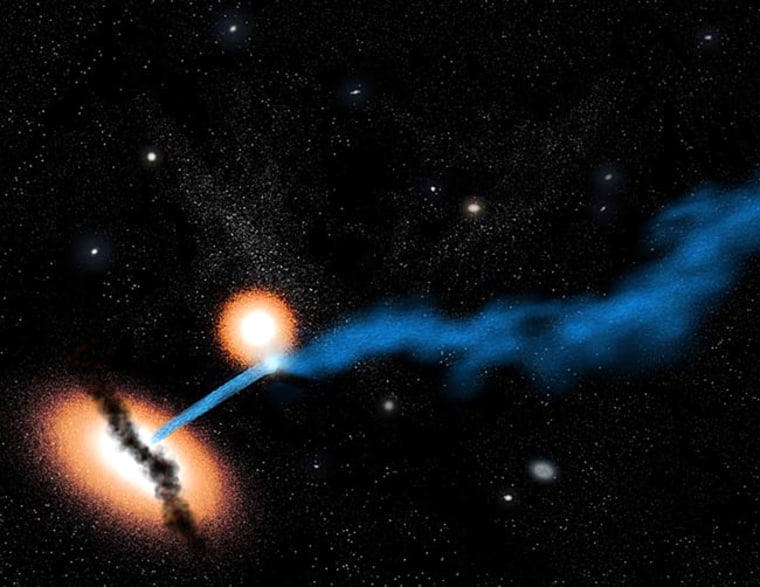
- This artist's impression of 3C321 shows the main galaxy and the companion galaxy. A jet of particles generated by a supermassive black hole at the center of the main galaxy is striking the companion galaxy. The jet is disrupted and deflected by this impact. The actual composite image of the phenomenon can be seen below. Credit: NASA/CXC/M. Weiss
ABC Science wrote:
Astronomers have spotted a distant galaxy zapping its smaller neighbour with a deadly particle beam.
The beam is a jet of particles moving at near light-speed out of a super-massive black hole at the centre of the larger galaxy.
The beam has smashed into the nearby second galaxy, where it is probably destroying an untold number of planets.
"There will be bad effects on earth-like planets," says astronomer Dr Daniel Evans of Harvard-Smithsonian Center for Astrophysics.
...
A wider view of the event shows that there are two hot spots a couple of million light-years apart, on either side of the galactic mugging.
These are the ends of the black hole's two polar jets, where they hit other material in intergalactic space.
The fact that the hot spot beyond the smaller galaxy is still lit up means it's still getting zapped with material that was sent flying before the smaller galaxy moved into the way and interrupted the beam.
Since it takes about a million years for light-speed particles to traverse the distance to the hot spots, the still lit-up hot spot means the smaller galaxy has been feeling the heat for less than a million years, Hardcastle says.
Well, shudder. I wouldn't want to be hit by an enormous beam of energetic particles from the accretion disk of a black hole in another galaxy!
Ann
Color Commentator
- AVAO
- Commander
- Posts: 526
- Joined: Tue May 28, 2019 12:24 pm
- AKA: multiwavelength traveller
- Location: Zurich, Switzerland
Re: GOTD: Galaxy Of The Day
Ann wrote: ↑Mon Jan 29, 2024 5:28 am
...
Could you please provide a link to the Chandra images of either the Hercules Cluster or of IC 1182 itself? I have been unable to find anything. To my knowledge, the only galaxy in Hercules that has been paid any special attention by either X-ray or radio-detecting telescopes is the radio galaxy Hercules A, which is not found in the same part of Hercules as the Hercules Galaxy Cluster.
...
- Visible light image obtained by the Earth-orbiting Hubble Space Telescope superposed with a radio image taken by the Very Large Array (VLA) of radio telescopes in New Mexico, USA. Credit: NASA, ESA, S. Baum and C. O'Dea (RIT), R. Perley and W. Cotton (NRAO/AUI/NSF), and the Hubble Heritage Team (STScI/AURA)
Ann
I think Hercules A is named that way because it is in the Hercules Supercluster and is huge.
However, this is very far away from the Hercules Cluster itself and should not cause any interactions with it.
Chandra in Blue & Green (Cores)
The Hercules Cluster of Galaxies. Credit: Rafael Bustamente
Re: GOTD: Galaxy Of The Day
AVAO wrote: ↑Mon Jan 29, 2024 6:26 amAnn wrote: ↑Mon Jan 29, 2024 5:28 am
...
Could you please provide a link to the Chandra images of either the Hercules Cluster or of IC 1182 itself? I have been unable to find anything. To my knowledge, the only galaxy in Hercules that has been paid any special attention by either X-ray or radio-detecting telescopes is the radio galaxy Hercules A, which is not found in the same part of Hercules as the Hercules Galaxy Cluster.
...
- Visible light image obtained by the Earth-orbiting Hubble Space Telescope superposed with a radio image taken by the Very Large Array (VLA) of radio telescopes in New Mexico, USA. Credit: NASA, ESA, S. Baum and C. O'Dea (RIT), R. Perley and W. Cotton (NRAO/AUI/NSF), and the Hubble Heritage Team (STScI/AURA)
Ann
I think Hercules A is named that way because it is in the Hercules Supercluster and is huge.
However, this is very far away from the Hercules Cluster itself and should not cause any interactions with it.
Chandra in Blue & Green (Cores)
The Hercules Cluster of Galaxies. Credit: Rafael Bustamente
Thanks, Jac, so interesting! I agree that NGC 6041 appears to be the dominant galaxy of the Hercules cluster with the most active black hole. NGC 6047 appears to have an active black hole, too. But IC 1182 looks just like all the other galaxies in the Chandra image. It doesn't look special at all.
Isn't it weird that a galaxy that produces such a long jet looks absolutely unremarkable in a Chandra image?
And hey, I just found a picture that proves that IC 1182 produces two jets, offset at an angle, just like M87!
Ann
Color Commentator
Re: GOTD: Galaxy Of The Day
I'm reminded of Hanny's Voorwerp, a strange object which, in Wikipedia-speak, is "a rare type of astronomical object called a quasar ionization echo."
So it would seem that Hanny's Voorwerp glows because of things that happened in the past. A quasar might have been involved, but it is no longer active.
Could the jet of IC 1182 also have been launched by a temporary flare-up of the black hole in IC 1182?
Ann
Wikipedia wrote:
Hanny's Voorwerp (HsV) is about the size of a small galaxy and has a central hole over 16,000 light years across. In an image taken with the Hubble Space Telescope, HsV is colored green, a standard false color that is used to represent the presence of several luminous emission lines of glowing oxygen. HsV has been shown to be at the same distance from Earth as the adjacent galaxy IC 2497, which is about 650 million light-years away.
One hypothesis suggests that HsV consists of remnants of a small galaxy showing the impact of radiation from a bright quasar event that occurred in the center of IC 2497 about 100,000 years before how it is observed today. The quasar event is thought to have stimulated the bright emission that characterizes HsV. The quasar might have switched off in the last 200,000 years and is not visible in the available images. This might well be due to a process known as AGN feedback.
One possible explanation for the missing light-source is that illumination from the assumed quasar was a transient phenomenon. In this case, its effects on HsV would be still visible because of the distance of several tens of thousands of light years between HsV and the quasar in the nearby galaxy: HsV would show a "light echo" or "ghost image" of events that are older than those currently seen in the galaxy.
So it would seem that Hanny's Voorwerp glows because of things that happened in the past. A quasar might have been involved, but it is no longer active.
Could the jet of IC 1182 also have been launched by a temporary flare-up of the black hole in IC 1182?
Ann
Color Commentator
- AVAO
- Commander
- Posts: 526
- Joined: Tue May 28, 2019 12:24 pm
- AKA: multiwavelength traveller
- Location: Zurich, Switzerland
Re: GOTD: Galaxy Of The Day
Ann wrote: ↑Mon Jan 29, 2024 7:00 amAVAO wrote: ↑Mon Jan 29, 2024 6:26 amAnn wrote: ↑Mon Jan 29, 2024 5:28 am
...
Could you please provide a link to the Chandra images of either the Hercules Cluster or of IC 1182 itself? I have been unable to find anything. To my knowledge, the only galaxy in Hercules that has been paid any special attention by either X-ray or radio-detecting telescopes is the radio galaxy Hercules A, which is not found in the same part of Hercules as the Hercules Galaxy Cluster.
...
- Visible light image obtained by the Earth-orbiting Hubble Space Telescope superposed with a radio image taken by the Very Large Array (VLA) of radio telescopes in New Mexico, USA. Credit: NASA, ESA, S. Baum and C. O'Dea (RIT), R. Perley and W. Cotton (NRAO/AUI/NSF), and the Hubble Heritage Team (STScI/AURA)
Ann
I think Hercules A is named that way because it is in the Hercules Supercluster and is huge.
However, this is very far away from the Hercules Cluster itself and should not cause any interactions with it.
Chandra in Blue & Green (Cores)
The Hercules Cluster of Galaxies. Credit: Rafael Bustamente
Thanks, Jac, so interesting! I agree that NGC 6041 appears to be the dominant galaxy of the Hercules cluster with the most active black hole. NGC 6047 appears to have an active black hole, too. But IC 1182 looks just like all the other galaxies in the Chandra image. It doesn't look special at all.
Isn't it weird that a galaxy that produces such a long jet looks absolutely unremarkable in a Chandra image?
And hey, I just found a picture that proves that IC 1182 produces two jets, offset at an angle, just like M87!
Ann
Maybe IC 1182 could have a similar structure to the shell galaxies NGC 1097 or NGC4651.
M87 is a different weight class...
IC 1182core: jac berne (flickr)
- AVAO
- Commander
- Posts: 526
- Joined: Tue May 28, 2019 12:24 pm
- AKA: multiwavelength traveller
- Location: Zurich, Switzerland
Re: GOTD: Galaxy Of The Day
Supernovas 1997 / 2016 / 2017 in row... jac berne (flickr)AVAO wrote: ↑Sun Jan 28, 2024 7:23 pm 28.01.2024 I Hubble: IC 438 - Luminous in Lepus
NASA/ESA | Original release 2024 Jan 22
GOTD4Y JacThis image shows the spiral galaxy IC 438, which lies about 130 million light-years from Earth in the constellation Lepus (the Hare). Lepus lies just south of the celestial equator (the ring around the middle of Earth that falls at right angles to its rotation axis). Appropriately, Lepus is flanked by the constellations Canis Major (the Greater Dog) and Orion (the Hunter), whilst Canis Minor (the Lesser Dog) lies very nearby, meaning that in artistic representations of the constellations, Lepus is often shown as being pursued by Orion and his two hunting dogs.
...
The impetus behind Hubble examining this galaxy was a type Iax supernova that took place in 2017, a kind of supernova that arises from a binary system of two stars. While this data was obtained over three years after the supernova occurred, and so it’s not visible in this image, there’s still a lot to learn from studying the aftermath of supernovae like this one.
...
more
- AVAO
- Commander
- Posts: 526
- Joined: Tue May 28, 2019 12:24 pm
- AKA: multiwavelength traveller
- Location: Zurich, Switzerland
Re: GOTD: Galaxy Of The Day
29.01.2024 I Hubble captures Arp 295
NASA/ESA | Original release 2024 Jan 26
NASA/ESA | Original release 2024 Jan 26
GOTD4Y JacOne of the galaxies from a galactic group known as Arp 295 is visible in this new NASA Hubble Space Telescope image, along with part of the faint 250,000-light-year-long bridge of stars and gas that stretches between two of the galaxies. The galaxies have passed close enough together that their mutual gravity created this cosmic streamer.
... more
Re: GOTD: Galaxy Of The Day
Indeed M87 is in a different weight class than M87, Jac. It is obvious that the jet in IC 1182 can't be caused by the same mechanism as the jet of M87.
I still don't think that the jet of IC 1182 looks very much like the fascinating jets of NGC 4651 or NGC 1097, because the jet of IC 1182 is so clumpy. But in any case, IC 1182 really doesn't seem to host an active black hole.
Ann
Color Commentator
Re: GOTD: Galaxy Of The Day
Wow Jac, IC 438 looks so impressive. Large, regular, handsome and majestic. To have sported three supernovas in such a short time is fascinating, too. And one of these supernovas was type Iax.AVAO wrote: ↑Mon Jan 29, 2024 10:44 pmSupernovas 1997 / 2016 / 2017 in row... jac berne (flickr)AVAO wrote: ↑Sun Jan 28, 2024 7:23 pm 28.01.2024 I Hubble: IC 438 - Luminous in Lepus
NASA/ESA | Original release 2024 Jan 22
GOTD4Y JacThis image shows the spiral galaxy IC 438, which lies about 130 million light-years from Earth in the constellation Lepus (the Hare). Lepus lies just south of the celestial equator (the ring around the middle of Earth that falls at right angles to its rotation axis). Appropriately, Lepus is flanked by the constellations Canis Major (the Greater Dog) and Orion (the Hunter), whilst Canis Minor (the Lesser Dog) lies very nearby, meaning that in artistic representations of the constellations, Lepus is often shown as being pursued by Orion and his two hunting dogs.
...
The impetus behind Hubble examining this galaxy was a type Iax supernova that took place in 2017, a kind of supernova that arises from a binary system of two stars. While this data was obtained over three years after the supernova occurred, and so it’s not visible in this image, there’s still a lot to learn from studying the aftermath of supernovae like this one.
...
more
As to what kind of supernovas we can expect to find in what kind of galaxies, sometimes the Universe surprises us! As it did in 2013 by blowing a core-collapse supernova in "almost red and dead" galaxy M65:
In 2006 the Universe treated us to an even greater surprise, when large lenticular and seemingly almost completely red and dead galaxy NGC 1260 blew a titanic supernova, SN 2006gy:

- Lenticular galaxy NGC 1260. I guess there might be some star formation in the central dust ring. We can also see two small blue objects in the disk. They may be star clusters, foreground stars or artifacts. The 'ring' in the upper left corner is certainly an artifact. Image credit: Hubble Legacy Archive/Fabian RRR.
Speaking of surprises, and returning to IC 438, Principal Galaxy Catalog (PGC), which is linked to my software Guide, claims that IC 438 is a small or at least a fairly dim galaxy, only 30% the luminosity of the Milky Way! I thought at first that PGC must have the distance to IC 438 completely wrong, but that doesn't seem to be the case. According to NASA, the distance to IC 438 is 130 million light years, and PGC says that the distance is 120 million light years. Those distances are not so different.
So could it possibly be true that IC 438 is smaller than the Milky Way? Really?
I guess it is possible. PGC classifies IC 438 as an SBc galaxy, a barred galaxy of Hubble class Sc. Well, the bar isn't prominent, but I agree that the galaxy looks like Hubble class Sc, where the galaxies have prominent arms and rather small centers. These galaxies are often smaller than the Milky Way. M74 is a good example.
Ann
Color Commentator
- AVAO
- Commander
- Posts: 526
- Joined: Tue May 28, 2019 12:24 pm
- AKA: multiwavelength traveller
- Location: Zurich, Switzerland
Re: GOTD: Galaxy Of The Day
AVAO wrote: ↑Mon Jan 29, 2024 10:51 pm 29.01.2024 I Hubble captures Arp 295
NASA/ESA | Original release 2024 Jan 26
GOTD4Y JacOne of the galaxies from a galactic group known as Arp 295 is visible in this new NASA Hubble Space Telescope image, along with part of the faint 250,000-light-year-long bridge of stars and gas that stretches between two of the galaxies. The galaxies have passed close enough together that their mutual gravity created this cosmic streamer.
... more
The NASA image is a bit dark.
SSD10 I jac berne (flickr)
...Arp 295 is made up of three spiral galaxies designated Arp 295a, Arp 295b, and Arp 295c. Arp 295a is the edge-on galaxy seen in the center of the image, and Arp 295c is the smaller and bluer face-on spiral to its right. Arp 295b is off the top left of this image and not visible here. Together, they are the largest of a loose grouping of galaxies located about 270 million light-years in the direction of the constellation Aquarius. ...
- AVAO
- Commander
- Posts: 526
- Joined: Tue May 28, 2019 12:24 pm
- AKA: multiwavelength traveller
- Location: Zurich, Switzerland
Re: GOTD: Galaxy Of The Day
AVAO wrote: ↑Sun Jan 28, 2024 7:23 pm 30.01.2024 I Image: Hubble spies side-by-side galaxies Arp 140
NASA/ESA | Original release 2024 Jan 25
GOTD4Y JacA barred spiral galaxy and a lenticular galaxy come together to create this interacting pair known as Arp 140. The lenticular galaxy, NGC 274, is visible on the right side of this new NASA Hubble Space Telescope image, and the barred spiral, NGC 275, is at left. The twosome is located in the constellation Cetus.
...
more
- AVAO
- Commander
- Posts: 526
- Joined: Tue May 28, 2019 12:24 pm
- AKA: multiwavelength traveller
- Location: Zurich, Switzerland
Re: GOTD: Galaxy Of The Day
...what's interesting is the third outer ring in the SDSS10 image of the small blue galaxy, which can only be seen with artificial brightening. I don't think this is just an artifact...AVAO wrote: ↑Wed Jan 31, 2024 6:16 amAVAO wrote: ↑Mon Jan 29, 2024 10:51 pm 29.01.2024 I Hubble captures Arp 295
NASA/ESA | Original release 2024 Jan 26
GOTD4Y JacOne of the galaxies from a galactic group known as Arp 295 is visible in this new NASA Hubble Space Telescope image, along with part of the faint 250,000-light-year-long bridge of stars and gas that stretches between two of the galaxies. The galaxies have passed close enough together that their mutual gravity created this cosmic streamer.
... more
The NASA image is a bit dark.
SSD10 I jac berne (flickr)
...Arp 295 is made up of three spiral galaxies designated Arp 295a, Arp 295b, and Arp 295c. Arp 295a is the edge-on galaxy seen in the center of the image, and Arp 295c is the smaller and bluer face-on spiral to its right. Arp 295b is off the top left of this image and not visible here. Together, they are the largest of a loose grouping of galaxies located about 270 million light-years in the direction of the constellation Aquarius. ...
- AVAO
- Commander
- Posts: 526
- Joined: Tue May 28, 2019 12:24 pm
- AKA: multiwavelength traveller
- Location: Zurich, Switzerland
Re: GOTD: Galaxy Of The Day
31.01.2024 I Arp 300: Hubble Observes an Askew Galaxy Coaxing Star Formation from its Partner
NASA/ESA | Original release 2024 Jan 23
NASA/ESA | Original release 2024 Jan 23
GOTD4Y JacArp 300 consists of two interacting galaxies, UGC 05028 (the smaller face-on spiral galaxy) and UGC 05029 (the larger face-on spiral). Likely due to its gravitational dance with its larger partner, UGC 05028 has an asymmetric, irregular structure, which is not as visible from ground-based telescopes but is quite distinct in this new image from NASA’s Hubble Space Telescope. The bright knot visible to the southeast of the center of UGC 05028 may be the remnant of another small galaxy that is in the process of merging with that galaxy. If this is the case, that remnant will eventually merge with the bar of stars visible in Hubble images of UGC 05028, forming a central bulge similar to that of Arp 300’s larger companion galaxy, UGC 05029. UGC 05029 has a pronounced spiral structure and multiple hot, blue giant stars visible on the side facing UGC 05028. This enhanced star formation is likely due to the interaction between the two galaxies. Another edge-on spiral galaxy is visible in this image below UGC 05029 but is too faint to be resolved into star-forming regions, while the five objects strung out above it are probably a group of distant background galaxies. Hubble looked at this galaxy pair to study the relationship between the overall physical characteristics of galaxies and their star formation.
... more
Re: GOTD: Galaxy Of The Day
AVAO wrote: ↑Thu Feb 01, 2024 9:12 pm 31.01.2024 I Arp 300: Hubble Observes an Askew Galaxy Coaxing Star Formation from its Partner
NASA/ESA | Original release 2024 Jan 23
GOTD4Y JacArp 300 consists of two interacting galaxies, UGC 05028 (the smaller face-on spiral galaxy) and UGC 05029 (the larger face-on spiral). Likely due to its gravitational dance with its larger partner, UGC 05028 has an asymmetric, irregular structure, which is not as visible from ground-based telescopes but is quite distinct in this new image from NASA’s Hubble Space Telescope. The bright knot visible to the southeast of the center of UGC 05028 may be the remnant of another small galaxy that is in the process of merging with that galaxy. If this is the case, that remnant will eventually merge with the bar of stars visible in Hubble images of UGC 05028, forming a central bulge similar to that of Arp 300’s larger companion galaxy, UGC 05029. UGC 05029 has a pronounced spiral structure and multiple hot, blue giant stars visible on the side facing UGC 05028. This enhanced star formation is likely due to the interaction between the two galaxies. Another edge-on spiral galaxy is visible in this image below UGC 05029 but is too faint to be resolved into star-forming regions, while the five objects strung out above it are probably a group of distant background galaxies. Hubble looked at this galaxy pair to study the relationship between the overall physical characteristics of galaxies and their star formation.
... more
Amazing, Jac! UGC 05028 has a dusty heart!
Ann
Color Commentator
- AVAO
- Commander
- Posts: 526
- Joined: Tue May 28, 2019 12:24 pm
- AKA: multiwavelength traveller
- Location: Zurich, Switzerland
Re: GOTD: Galaxy Of The Day
Ann wrote: ↑Fri Feb 02, 2024 6:26 amAVAO wrote: ↑Thu Feb 01, 2024 9:12 pm 31.01.2024 I Arp 300: Hubble Observes an Askew Galaxy Coaxing Star Formation from its Partner
NASA/ESA | Original release 2024 Jan 23
GOTD4Y JacArp 300 consists of two interacting galaxies, UGC 05028 (the smaller face-on spiral galaxy) and UGC 05029 (the larger face-on spiral). Likely due to its gravitational dance with its larger partner, UGC 05028 has an asymmetric, irregular structure, which is not as visible from ground-based telescopes but is quite distinct in this new image from NASA’s Hubble Space Telescope. The bright knot visible to the southeast of the center of UGC 05028 may be the remnant of another small galaxy that is in the process of merging with that galaxy. If this is the case, that remnant will eventually merge with the bar of stars visible in Hubble images of UGC 05028, forming a central bulge similar to that of Arp 300’s larger companion galaxy, UGC 05029. UGC 05029 has a pronounced spiral structure and multiple hot, blue giant stars visible on the side facing UGC 05028. This enhanced star formation is likely due to the interaction between the two galaxies. Another edge-on spiral galaxy is visible in this image below UGC 05029 but is too faint to be resolved into star-forming regions, while the five objects strung out above it are probably a group of distant background galaxies. Hubble looked at this galaxy pair to study the relationship between the overall physical characteristics of galaxies and their star formation.
... more
Amazing, Jac! UGC 05028 has a dusty heart!
Ann
... the NASA version is a bit too hard for me and has too much cyan...
jac berne (flickr) Original data: NASA ESA
- AVAO
- Commander
- Posts: 526
- Joined: Tue May 28, 2019 12:24 pm
- AKA: multiwavelength traveller
- Location: Zurich, Switzerland
Re: GOTD: Galaxy Of The Day
01.02.2024 I HST: Hubble captures a suspected galaxy encounter
phys.org | Original release 2024 Feb 01
phys.org | Original release 2024 Feb 01
GOTD4Y JacUGC 3912 is classified as a spiral galaxy, but you wouldn't know it from this detailed NASA HST image. UGC 3912's distorted shape is typically indicative of a gravitational encounter with another galaxy. ....UGC 3912 might have once been an organized-looking spiral, but it looks like it's been smudged out of shape by a giant thumb.
...
Astronomers are studying UGC 3912 as part of an investigation into supernovae activity—when stars at least eight times larger than our sun explode at the end of their lives. Hubble is examining one of the several types of supernovae, a hydrogen-rich phenomenon known as Type II. ...
... read more




